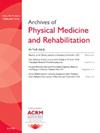康复出院时的功能能力预测全膝关节置换术患者24周后的身体活动特征:一项随机对照试验的二次分析。
IF 3.6
2区 医学
Q1 REHABILITATION
Archives of physical medicine and rehabilitation
Pub Date : 2025-06-01
DOI:10.1016/j.apmr.2025.01.416
引用次数: 0
摘要
目的:在全膝关节置换术(TKA)后38周的平均每日步数和峰值步行节奏中,确定基于表现和患者报告的12周康复结束时的功能能力之间的关系。设计:随机对照试验的二次分析。地点:退伍军人事务医疗中心。参与者:87名美国退伍军人(年龄:67±7岁,87%为男性)。干预措施:tka后两周开始为期12周的康复,随机分配到基于远程医疗的身体活动行为改变干预(PABC)或对照组。主要结果测量:在康复出院时(tka后14周)评估基于性能的(时间起-走(TUG), 30秒坐-站)和患者报告的测量(西安大略省和麦克马斯特大学骨关节炎指数(WOMAC),退伍军人兰德12项健康调查(VR12))。tka后38周,使用大腿加速度计测量身体活动。使用单变量和多变量线性和逻辑回归评估参与者特征(年龄、性别、BMI、分组分配)、出院时的功能能力和长期身体活动结果(平均每日步数和峰值步行节奏)之间的关系。结果:单因素分析:TUG时间(r= -0.33, p=0.002)和VR12身体健康亚评分(r= 0.23, p=0.036)与第38周的平均每日步数相关。TUG时间(r= -0.31, p=0.006)与峰值步行节奏相关。多因素分析:控制年龄、性别和BMI的多元线性回归确定了TUG (B= -301.25, p=0.039)和VR12身体健康(B= 93.1;P =0.049)作为每日步数的预测因子。TUG时间(B= -1.5, p=0.012)和PABC干预分配(B= 13.7, p)结论:tka后38周出院时的功能能力与身体活动特征有关。虽然需要行为改变干预措施来解决术后身体活动缺陷,但功能能力和活动之间的联系表明,在TKA康复期间需要解决功能能力限制问题。本文章由计算机程序翻译,如有差异,请以英文原文为准。
Functional Capacity at Rehabilitation Discharge Predicts Physical Activity Characteristics 24 Weeks Later for People With Total Knee Arthroplasty: A Secondary Analysis of a Randomized Controlled Trial
Objective
To determine the association between performance-based and patient-reported functional capacity at the conclusion of 12-week rehabilitation with average daily step counts and peak walking cadence 38 weeks after total knee arthroplasty (TKA).
Design
Secondary analysis of a randomized controlled trial.
Setting
Veterans Affairs Medical Center.
Participants
A total of 87 US military Veterans (age: 67±7y, 87% male).
Interventions
Twelve-week rehabilitation beginning 2 weeks post-TKA plus random assignment to either a telehealth-based physical activity behavior change intervention or control group.
Main Outcome Measures
Performance-based (timed Up-and-Go [TUG], 30-second sit-to-stand) and patient-reported measures (Western Ontario and McMaster Universities Osteoarthritis Index, Veterans RAND 12-Item Health Survey [VR-12]) were assessed at rehabilitation discharge (14wk post-TKA). Physical activity was measured using thigh-mounted accelerometry 38 weeks post-TKA. Relationships between participant characteristics (age, sex, body mass index, group assignment), functional capacity at discharge, and long-term physical activity outcomes (average daily step count and peak walking cadence) were evaluated using single- and multiple-variable linear and logistic regressions.
Results
Univariate analyses: TUG time (r=−0.33, P=.002) and VR-12 physical health subscore (r=0.23, P=.036) were correlated with average daily step count at week 38. TUG time (r=−0.31, P=.006) was correlated with peak walking cadence. Multivariate analyses: multiple linear regression controlling for age, sex, and body mass index identified TUG (B=−301.25, P=.039) and VR-12 physical health (B=93.1, P=.049) as predictors of daily step count. TUG time (B=−1.5, P=.012) and assignment to physical activity behavior change intervention (B=13.7, P<.001) predicted peak walking cadence. No significant predictors of attaining a 7500 steps per day threshold were identified.
Conclusions
Functional capacity at discharge is related to physical activity characteristics 38 weeks post-TKA. Although behavior change interventions are needed to address physical activity deficits postoperatively, the link between functional capacity and activity suggests additional need to address functional capacity limitations during TKA rehabilitation.
求助全文
通过发布文献求助,成功后即可免费获取论文全文。
去求助
来源期刊
CiteScore
6.20
自引率
4.70%
发文量
495
审稿时长
38 days
期刊介绍:
The Archives of Physical Medicine and Rehabilitation publishes original, peer-reviewed research and clinical reports on important trends and developments in physical medicine and rehabilitation and related fields. This international journal brings researchers and clinicians authoritative information on the therapeutic utilization of physical, behavioral and pharmaceutical agents in providing comprehensive care for individuals with chronic illness and disabilities.
Archives began publication in 1920, publishes monthly, and is the official journal of the American Congress of Rehabilitation Medicine. Its papers are cited more often than any other rehabilitation journal.

 求助内容:
求助内容: 应助结果提醒方式:
应助结果提醒方式:


